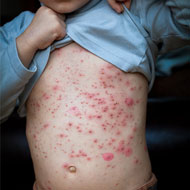- Toddler Measles Symptoms
- Toddler Flu Treatment
- Toddler Flu Symptoms
- Toddler Stomach Flu Symptoms
- Toddler Hair Loss
- Toddler Urinary Tract Infection Symptoms
- Toddler Tonsillectomy Recovery
- Toddler Periorbital Cellulitis
- Toddler Vomiting and Diarrhea
- Types of Toddler Vomiting
- Toddler Vomiting Treatment
- Toddler Cough Vomit
- Toddler Dandruff
- Toddler Bowlegs
- Toddler Eye Infection
- Toddler Pink Eye
- Toddler Pink Eye Symptoms
- Toddler Eye Problems
- Toddler Hearing Loss Signs
- Symptoms Of Pinworms In Toddlers
- Toddler Blood Infection
- Toddler Mononucleosis
- Toddler Motion Sickness
- Toddler Labial Adhesion
- Lyumphoma in Toddlers
- Toddler Scabies
- Toddler Pinworms
- Toddler Insect Bites
- Toddler Meningitis
- Toddler Moles
- Toddler Lyme Disease
- Toddler Nosebleeds
- Toddler Ingrown Toenail
- Toddler Lead Poisoning
- Toddler Hair Loss Alopecia Areata
- Toddler Heat Stroke
- Toddler Rubella
- Toddler Tonsillectomy
- Toddler Iron-Deficiency Anemia
- Toddler Tooth Discoloration
- Toddler Concussion
- Toddler Psoriasis
- Toddler Sunburn
- Toddler Tongue Blisters
- Toddler Blepharitis
- Toddler Burns
- Toddler Burn Treatment
- Toddler Eczema Face
- Toddler Eczema Symptoms
- Toddler Urinary Tract Infection
- Toddler Boy Urinary Tract Infection
- Toddler Epilepsy
- Toddler Epilepsy Symptoms
- Toddler Walking Pneumonia
- Toddler Yeast Infection Symptoms
- Toddler Frostbite
- Toddler Hand Foot And Mouth Disease
- Toddler Dry Scalp
- Toddler Dry Skin
- Toddler Strep Throat
- Toddler Strep Throat Symptoms
- Toddler Sore Throat
- Toddler Mumps
- Toddler Bacterial Infection
- Shaken Baby Syndrome
- Shaken Baby Syndrome Symptoms
- Toddler Tonsillitis
- Toddler Eye Discharge
- Toddler Fifth Disease
- Toddler Febrile Seizures
- Toddler Food Poisoning
- Toddler Gingivostomatitis
- Toddler Stomach Ache
- Toddler Warts
- Toddler Tuberculosis
- Toddler Torticollis
- Toddler Tick Bites
- Toddler Ear Infection Remedies
- Toddler Ear Infection Symptoms
- Toddler Ear Infection Signs
- Toddler Concussion Signs
- Toddler Bronchitis
- Toddler Colds
- Toddler Chicken Pox
- Toddler Appendicitis
- Toddler Asthma
- Toddler Birthmarks
- Toddler Strabismus
- Toddler Wheezing
- Toddler Sprains
- Toddlers Tinea Versicolor
- Toddler Viral Infection
- Toddler Yeast Infection
- Toddler Hives
- Toddler Canker Sores
How To Deal With Impetigo In Toddlers
As parents you tend to brace yourself for the regular flu attacks and bruises or aches that your toddler will develop but it will throw you off if your doctor tells you your child has impetigo.
It sounds like a scary disease and truth be told it looks nasty too, but it's not as serious as it sounds.
Impetigo is in fact pretty common among toddlers. Before you understand how to deal with it, you need to know why it happens.
Causes of Impetigo in Toddlers
Impetigo is caused by bacteria called streptococcus, these bacteria are actually already prevalent in the nose, throat and skin of several individuals. In fact it is quite possible that you carry these bacteria without showing any symptoms.
Impetigo, however, only occurs when there is a cut or break in the skin, which then allows the bacteria to act up or enter. As we all know toddlers frequently have runny noses, which you have to constantly keep wiping. This nasal mucous sometimes cracks the skin, allowing the bacteria to infect the area. See also toddler rashes
Hence, it is also common that impetigo occurs largely in the face, especially around the nose and mouth. The impetigo infection also occurs because of diaper rash. For the uninitiated, impetigo takes the form of a blister or red lump, much like eczema, only this is caused by different bacteria. In impetigo, you will notice that the infected area has a crusty, honey-colored look. Most often parents will find that before the infection occurs, the particular area will have a red tender look. Needless to say, but impetigo is contagious and it spreads through physical contact, so it's quite common for impetigo to spread in preschool and daycares.
Dealing with Toddler Impetigo
To deal with impetigo in toddlers you have to know how to spot it. Usually the first signs of impetigo are tiny blisters which appear most commonly under the nose or around the mouth. These blisters contain a pale fluid underneath. When these blisters burst, they tend to leave a crusty area on the skin, usually honey colored or yellow in color. So, your toddler could have a crusty patch on the face, which on closer inspection has inflamed red skin below.
Also, impetigo usually affects in small patches, but these can be real itchy.
Now that you know how it looks, your next task is to contain it. Since it spreads through physical contact, you need to discourage your child from scratching, rubbing or indeed if possible even touching it. Next, you need to ensure that his infection doesn't spread to others. Wash and sterilize all his linen, toys, clothes and do not share anything, be it towels, washcloth or any other item with your child.
Keep the toddler away from his peers; isolate him for at least a couple of days after his treatment begins. Depending on how extensive the impetigo is the doctor will suggest a treatment. If there are several patches all over the body, then the doctor may well prescribe tablets in addition to ointments. Sometimes, you can treat it only with the ointments too.
Be sure to wash the area and pat it dry before applying the ointment. Also, wash your hands with warm water once done. These precautions are necessary because of the contagious nature of this infection. Typically, it takes about a week or ten days for the infection to cure.
Impetigo in toddlers doesn't have too many complications besides an itchy feel and crusty look. Nevertheless, while it lasts, it's a painful experience for your toddler and hence needs to be dealt with promptly.


